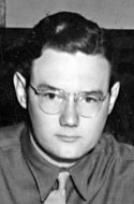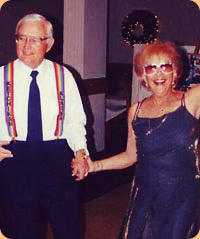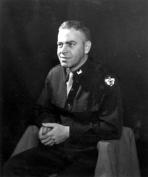
shemya scrapbooks
ian beaton - 1943-1945

I
served
on
Shemya
from
11/43
to
7/45.
I
had
a
45
day
furlough
in
July,
1945,
after
which
I
was
scheduled
to
return
to
Shemya.
However
the
war
ended
while
I
was
home.
I
got
an
early
out
11/5/45
because
I
had
a
bunch
of
discharge
points
and
because
there
was
not
enough
transport
to
get
the
really
high
point
guys
home
from
the
PTO
or
Europe.
In
fact,
many
didn't
get
home
until
'46.
A
one-
time
event
in
US
History
occurred
when
an
Anchorage-based
Federal
Judge
Diamond
and
his
clerk
were
flown
1200
miles
down
the
Aleutian
chain
to
Attu
to
conduct
Naturalization
procedures
for
those
who
had
served
honorably
with
the
United
States
Armed
Forces
and
who
were
21
years
of
age
or
older.
The
photo
below
(#19)
shows
a
photo
of
me
during
this
process,
where
I
had
my
first
conversation
with
a
female
in
over
2
years.
However,
it
was
brief.
She
said,
"sign
here
Corporal"
and
I
said
"Yes
Ma'am."
Prior
to
this
happening,
I
had
to
get
documentation
from
my
father
back
in
Michigan
that we had entered the United States legally.
We traveled to Attu by Army barge and I was accompanied by our Company Captain
and 1st Sergeant. We returned to Shemya by barge and I had an opportunity to try out
my anti-seasick pills. The first anti-seasick medication was developed by the
University of Toronto for the Canadian Navy whose main mission was escorting
convoys in their small Corvette class DEs. One of my 1st cousins was a Surgeon
Commander, in the Canadian Navy, and he sent a bottle of these pills to me and my
cousin Lorne who was an Ensign in the US Navy serving on a DE in the South Pacific.
The label on the bottle indicated these pills came directly
from the University lab. The sea was very rough on our
return trip to Shemya and I had secretly taken a couple of
these pills. They worked like a charm and I was really
impressed. In fact, we had a greasy dinner on board and
before long guys were hanging over the railing unloading
their dinners. I never used them again because a few weeks
later, we were given 45 day furloughs and were flown home
in C-457s. The Flint (MI) Journal published my story without
using the photo. I am one of ten men in the history of the
United States whose citizenship certificate indicates I was a
resident of Shemya and I was naturalized on Attu.
Ian Beaton


[Editor's Notes: Ian, like many stationed in the Aleutians during WWII, spent time on several of the
islands. You'll find other pages with photos from Ian on this web site as well through a "Site Search." Ian
also authored the book "They Also Serve," found on our site's Bibliography page.]


1. General's quarters on Shemya. The AF General's house
built by Force Utilities. On special occasions, the General
would throw a party. My buddy, Bob Hunniford, leader of the
"Jive Bombers" Combo would provide the music. To help even
up the male/female relationship, B-24s collected nurses from
nearby bases to attend the function along with Shemya
nurses.


2. Captain Reger, Post Engineer, formerly of the 50th
Engineers which helped build the Alcan Highway.
![Shemya Post Engineer George Cox, 1945. [Ian Beaton]](index_htm_files/80213.jpg)
![Shemya Post Engineer George Cox, 1945. [Ian Beaton]](index_htm_files/74505.png)
3. Post Engineer George Cox next to our Headquarters Sign in
1945. The inscription next to the "Women" category reads
"Atchd for Rations - 3"
![Shemya Utilites (1943-44): Fuel Oil & Water. {Ian Beaton]](index_htm_files/80214.jpg)
![Shemya Utilites (1943-44): Fuel Oil & Water. {Ian Beaton]](index_htm_files/60368.jpg)
![Shemya Utilites (1943-44): Fuel Oil & Water. {Ian Beaton]](index_htm_files/60369.jpg)
4. Our "utilities" in 1943 and early 1944. Fuel oil for our hut
heaters and water to wash, usually accomplished by filling up
your helmet and heating the water on the oil stove.
![Shemya's Pacific-side Beach Defenses. [Ian Beaton]](index_htm_files/80215.jpg)
![Shemya's Pacific-side Beach Defenses. [Ian Beaton]](index_htm_files/74506.png)
5. Shemya "Beach Defenses" on the Pacific side. We would
have been an easy target for Japanese raiding parties.

![Ian Beaton in Casual Dress Uniform. [Ian Beaton]](index_htm_files/80217.jpg)
![Ian Beaton in Casual Dress Uniform. [Ian Beaton]](index_htm_files/74507.png)
6. Ian Beaton in his "casual" uniform.
![Ian Beaton On Watch. [Ian Beaton]](index_htm_files/80218.jpg)
![Ian Beaton On Watch. [Ian Beaton]](index_htm_files/74508.png)
7. Ian Beaton on watch.
![Ian Beaton In Office. [Ian Beaton]](index_htm_files/80219.jpg)
![Ian Beaton In Office. [Ian Beaton]](index_htm_files/74509.png)
8. Ian in his office, slaving away over tedious documentation.
![Martha O'Driscoll (R) Visiting Shemya. [Ian Beaton]](index_htm_files/80220.jpg)
![Martha O'Driscoll (R) Visiting Shemya. [Ian Beaton]](index_htm_files/74510.png)
9. Martha O'Driscoll, a gorgeous "B" movie blonde on the
right, visiting Shemya. Unknown person on the left. Martha
would have been around 22 years old at this time.
![Post Engineer's New Mess Hall. Edward Alig On Right. [Ian Beaton]](index_htm_files/80221.jpg)
![Post Engineer's New Mess Hall. Edward Alig On Right. [Ian Beaton]](index_htm_files/74511.png)
10. Post Engineer's new mess hall. Edward Alig from Detroit is
on the right.
![Francis Gallagher (L) & Bob (R), Post Engineer Warehousemen. [Ian Beaton]](index_htm_files/80222.jpg)
![Francis Gallagher (L) & Bob (R), Post Engineer Warehousemen. [Ian Beaton]](index_htm_files/74512.png)
11. Post Engineer warehousemen, Francis Gallagher on the
left and Bob ? on the right.
![Practice Firing 20mm AA Guns. [Ian Beaton]](index_htm_files/80223.jpg)
![Practice Firing 20mm AA Guns. [Ian Beaton]](index_htm_files/74513.png)
12. Early on, Shemya's only protection from Japanese
bombers was an AA Coast Artillery unit with 4ea 90MM guns.
which if the attackers came in at low level, the 90s would be
useless. To help correct this problem, the post engineer was
given 2ea 20MM AA guns and 2ea 50 Caliber water cooled
machine guns. Because I was a trained infantry machine
gunner, I was the chief gunner on one of the 20s. We
practiced firing at a sleeve pulled by a brightly painted B-26.
However, one day the B-26 crashed on takeoff and was
totaled. The crew escaped without injury. From then on, we
fired at whales which could be seen passing Shemya
frequently. To my knowledge, no whales were ever hit and
the Japanese never attacked Shemya
![Building Shemya's 10,000 ft. Runway. [Ian Beaton]](index_htm_files/80224.jpg)
![Building Shemya's 10,000 ft. Runway. [Ian Beaton]](index_htm_files/74514.png)
13.Building Shemya's long runway...in preparation for
anticipated B-29 landings and takeoffs from Shemya. [A plan
was to use Shemya as a B-29 base from which to launch the
ultimate attack against the Japanese homeland]
![Sgt. Red Thorpe, Shemya Post Engineers. [Ian Beaton]](index_htm_files/80225.jpg)
![Sgt. Red Thorpe, Shemya Post Engineers. [Ian Beaton]](index_htm_files/74512.png)
14. Sgt. Red Thorpe, Post Engineer, Shemya.
![Shemya's Easter Church Service, 1945. [Ian Beaton]](index_htm_files/80226.jpg)
![Shemya's Easter Church Service, 1945. [Ian Beaton]](index_htm_files/74515.png)
15. Easter Church services, 1945 in the new movie theater.
![Shemya Church Services. [Ian Beaton]](index_htm_files/80227.jpg)
![Shemya Church Services. [Ian Beaton]](index_htm_files/74516.png)
16. Church services, Shemya.
![Shemya's "Jive Bombers," Celebrating Opening of Post Engineer Mess Hall. [Ian Beaton]](index_htm_files/80228.jpg)
![Shemya's "Jive Bombers," Celebrating Opening of Post Engineer Mess Hall. [Ian Beaton]](index_htm_files/74517.png)
17. Celebration of the opening of the Post Engineer mess
hall. Bob Hunniford (on drums) was the leader of the "Jive
Bombers." The guy in front had just come back from an
emergency furlough and was demonstrating how folks
back in the States got clean by taking something called a
"bath" in a tub. It was funny!
![L-R: Bill Benham, Walter Hickey, & Ian Beaton, Post Engineers. [Ian Beaton]](index_htm_files/80229.jpg)
![L-R: Bill Benham, Walter Hickey, & Ian Beaton, Post Engineers. [Ian Beaton]](index_htm_files/74518.png)
18. Aleutian buddies, Post Engineer, (L to R) Bill Benham,
Walter Hickey and Ian Beaton
![Ian Beaton Signing Naturalization Papers on Attu. [Ian Beaton]](index_htm_files/80230.jpg)
![Ian Beaton Signing Naturalization Papers on Attu. [Ian Beaton]](index_htm_files/74519.png)
19. The first conversation Ian had with a female in over
two years was when he was asked to "sign here" during his
citizenship application and naturalization process on Attu.
![Shemya Post Engineer's Mail Clerk Tom Barron (sitting) with Ian Beaton. [Ian Beaton]](index_htm_files/80231.jpg)
![Shemya Post Engineer's Mail Clerk Tom Barron (sitting) with Ian Beaton. [Ian Beaton]](index_htm_files/74520.png)
20. Post Engineer Mail Clerk Tom Barron, sitting in his jeep
with Ian Beaton on the left. Tom later rolled his jeep and
ended up in the hospital for a short stay.
![Ian Beaton Sitting On His Cot In His Hut. [Ian Beaton]](index_htm_files/80232.jpg)
![Ian Beaton Sitting On His Cot In His Hut. [Ian Beaton]](index_htm_files/74521.png)
21. Ian sitting on the cot in his hut.
![Sheymya's Russian Sailor's Graves. [Ian Beaton]](index_htm_files/80233.jpg)
![Sheymya's Russian Sailor's Graves. [Ian Beaton]](index_htm_files/74522.png)
22. Russian Sailor's graves, Shemya.
[Editor’s Notes: Ian Wilson Beaton was born in Sidney, Nova Scotia, Canada in 1925.
He accompanied his parents at the age of 1 year old crossing the border at Port
Huron Michigan, finally settling in Flint, MI. While serving as a T-5 with the U. S. Army
in the Aleutians, Ian became a naturalized citizen of the United States on the 10th of
Jul 1945 signing his paperwork on Attu, AK. He married Carol Jean Lindner on 30 Dec
1950 in Flint, Michigan at the age of 25. Ian passed away on 28 Nov 2005.]
Current Update: 06/09/2022 15:18
Originally Published: July 2005

shemya scrapbooks
ian beaton - 1943-1945

I
served
on
Shemya
from
11/43
to
7/45.
I
had
a
45
day
furlough
in
July,
1945,
after
which
I
was
scheduled
to
return
to
Shemya.
However
the
war
ended
while
I
was
home.
I
got
an
early
out
11/5/45
because
I
had
a
bunch
of
discharge
points
and
because
there
was
not
enough
transport
to
get
the
really
high
point
guys
home
from
the
PTO
or
Europe.
In
fact,
many
didn't
get
home
until
'46.
A
one-time
event
in
US
History
occurred
when
an
Anchorage-
based
Federal
Judge
Diamond
and
his
clerk
were
flown
1200
miles
down
the
Aleutian
chain
to
Attu
to
conduct
Naturalization
procedures
for
those
who
had
served
honorably
with
the
United
States
Armed
Forces
and
who
were
21
years
of
age
or
older.
The
photo
below
(#19)
shows
a
photo
of
me
during
this
process,
where
I
had
my
first
conversation
with
a
female
in
over
2
years.
However,
it
was
brief.
She
said,
"sign
here
Corporal"
and
I
said
"Yes
Ma'am."
Prior
to
this
happening,
I
had
to
get
documentation
from
my
father
back
in
Michigan
that
we
had
entered
the
United
States legally.
We traveled to Attu by Army barge and I was
accompanied by our Company Captain and 1st
Sergeant. We returned to Shemya by barge and I had
an opportunity to try out my anti-seasick pills. The
first anti-seasick medication was developed by the
University of Toronto for the Canadian Navy whose
main mission was escorting convoys in their small
Corvette class DEs. One of my 1st cousins was a
Surgeon Commander, in the Canadian Navy, and he
sent a bottle of these pills to me and my cousin Lorne
who was an Ensign in the US Navy serving on a DE in
the South Pacific. The label on the bottle indicated
these pills came directly from the University lab. The
sea was very rough on our return trip to Shemya and I
had secretly taken a couple of these pills. They worked
like a charm and I was really impressed. In fact, we
had a greasy dinner on board and before long guys
were hanging over the railing unloading their dinners.
I never used them again
because a few weeks later,
we were given 45 day
furloughs and were flown
home in C-457s. The Flint
(MI) Journal published my
story without using the
photo. I am one of ten men
in the history of the United
States whose citizenship
certificate indicates I was a
resident of Shemya and I
was naturalized on Attu.
Ian Beaton


[Editor's Notes: Ian, like many stationed in the Aleutians during
WWII, spent time on several of the islands. You'll find other pages
with photos from Ian on this web site as well through a "Site
Search." Ian also authored the book "They Also Serve," found on
our site's Bibliography page.]


1. General's quarters on Shemya.
The AF General's house built by
Force Utilities. On special
occasions, the General would
throw a party. My buddy, Bob
Hunniford, leader of the "Jive
Bombers" Combo would provide
the music. To help even up the
male/female relationship, B-24s
collected nurses from nearby
bases to attend the function
along with Shemya nurses.


2. Captain Reger, Post Engineer,
formerly of the 50th Engineers
which helped build the Alcan
Highway.
![Shemya Post Engineer George Cox, 1945. [Ian Beaton]](index_htm_files/80213.jpg)
![Shemya Post Engineer George Cox, 1945. [Ian Beaton]](index_htm_files/89388.png)

![Shemya Utilites (1943-44): Fuel Oil & Water. {Ian Beaton]](index_htm_files/80214.jpg)
![Shemya Utilites (1943-44): Fuel Oil & Water. {Ian Beaton]](index_htm_files/89389.jpg)
![Shemya Utilites (1943-44): Fuel Oil & Water. {Ian Beaton]](index_htm_files/89390.jpg)
4. Our "utilities" in 1943 and early
1944. Fuel oil for our hut heaters
and water to wash, usually
accomplished by filling up your
helmet and heating the water on
the oil stove.
![Shemya's Pacific-side Beach Defenses. [Ian Beaton]](index_htm_files/80215.jpg)
![Shemya's Pacific-side Beach Defenses. [Ian Beaton]](index_htm_files/89391.png)
5. Shemya "Beach Defenses" on
the Pacific side. We would have
been an easy target for Japanese
raiding parties.

![Ian Beaton in Casual Dress Uniform. [Ian Beaton]](index_htm_files/80217.jpg)
![Ian Beaton in Casual Dress Uniform. [Ian Beaton]](index_htm_files/74507.png)
6. Ian Beaton in his "casual"
uniform.
![Ian Beaton On Watch. [Ian Beaton]](index_htm_files/80218.jpg)
![Ian Beaton On Watch. [Ian Beaton]](index_htm_files/74508.png)
7. Ian Beaton on watch.
![Ian Beaton In Office. [Ian Beaton]](index_htm_files/80219.jpg)
![Ian Beaton In Office. [Ian Beaton]](index_htm_files/89392.png)
8. Ian in his office, slaving away
over tedious documentation.
![Martha O'Driscoll (R) Visiting Shemya. [Ian Beaton]](index_htm_files/80220.jpg)
![Martha O'Driscoll (R) Visiting Shemya. [Ian Beaton]](index_htm_files/74510.png)
9. Martha O'Driscoll, a gorgeous
"B" movie blonde on the right,
visiting Shemya. Unknown
person on the left. Martha would
have been around 22 years old at
this time.
![Post Engineer's New Mess Hall. Edward Alig On Right. [Ian Beaton]](index_htm_files/80221.jpg)
![Post Engineer's New Mess Hall. Edward Alig On Right. [Ian Beaton]](index_htm_files/74515.png)
10. Post Engineer's new mess
hall. Edward Alig from Detroit is
on the right.
![Francis Gallagher (L) & Bob (R), Post Engineer Warehousemen. [Ian Beaton]](index_htm_files/80222.jpg)
![Francis Gallagher (L) & Bob (R), Post Engineer Warehousemen. [Ian Beaton]](index_htm_files/74512.png)
11. Post Engineer warehousemen,
Francis Gallagher on the left and
Bob ? on the right.
![Practice Firing 20mm AA Guns. [Ian Beaton]](index_htm_files/80223.jpg)
![Practice Firing 20mm AA Guns. [Ian Beaton]](index_htm_files/74513.png)
12. Early on, Shemya's only
protection from Japanese
bombers was an AA Coast
Artillery unit with 4ea 90MM
guns. which if the attackers came
in at low level, the 90s would be
useless. To help correct this
problem, the post engineer was
given 2ea 20MM AA guns and 2ea
50 Caliber water cooled machine
guns. Because I was a trained
infantry machine gunner, I was
the chief gunner on one of the
20s. We practiced firing at a
sleeve pulled by a brightly
painted B-26. However, one day
the B-26 crashed on takeoff and
was totaled. The crew escaped
without injury. From then on, we
fired at whales which could be
seen passing Shemya frequently.
To my knowledge, no whales
were ever hit and the Japanese
never attacked Shemya
![Building Shemya's 10,000 ft. Runway. [Ian Beaton]](index_htm_files/80224.jpg)
![Building Shemya's 10,000 ft. Runway. [Ian Beaton]](index_htm_files/89393.png)
13.Building Shemya's long
runway...in preparation for
anticipated B-29 landings and
takeoffs from Shemya. [A plan
was to use Shemya as a B-29 base
from which to launch the
ultimate attack against the
Japanese homeland]
![Sgt. Red Thorpe, Shemya Post Engineers. [Ian Beaton]](index_htm_files/80225.jpg)
![Sgt. Red Thorpe, Shemya Post Engineers. [Ian Beaton]](index_htm_files/74512.png)
14. Sgt. Red Thorpe, Post
Engineer, Shemya.
![Shemya's Easter Church Service, 1945. [Ian Beaton]](index_htm_files/80226.jpg)
![Shemya's Easter Church Service, 1945. [Ian Beaton]](index_htm_files/89394.png)
15. Easter Church services, 1945
in the new movie theater.
![Shemya Church Services. [Ian Beaton]](index_htm_files/80227.jpg)
![Shemya Church Services. [Ian Beaton]](index_htm_files/89395.png)
16. Church services, Shemya.
![Shemya's "Jive Bombers," Celebrating Opening of Post Engineer Mess Hall. [Ian Beaton]](index_htm_files/80228.jpg)
![Shemya's "Jive Bombers," Celebrating Opening of Post Engineer Mess Hall. [Ian Beaton]](index_htm_files/89396.png)
17. Celebration of the opening of
the Post Engineer mess hall. Bob
Hunniford (on drums) was the
leader of the "Jive Bombers." The
guy in front had just come back
from an emergency furlough and
was demonstrating how folks
back in the States got clean by
taking something called a "bath"
in a tub. It was funny!
![L-R: Bill Benham, Walter Hickey, & Ian Beaton, Post Engineers. [Ian Beaton]](index_htm_files/80229.jpg)
![L-R: Bill Benham, Walter Hickey, & Ian Beaton, Post Engineers. [Ian Beaton]](index_htm_files/89397.png)
18. Aleutian buddies, Post
Engineer, (L to R) Bill Benham,
Walter Hickey and Ian Beaton
![Ian Beaton Signing Naturalization Papers on Attu. [Ian Beaton]](index_htm_files/80230.jpg)
![Ian Beaton Signing Naturalization Papers on Attu. [Ian Beaton]](index_htm_files/89398.png)
19. The first conversation Ian had
with a female in over two years
was when he was asked to "sign
here" during his citizenship
application and naturalization
process on Attu.
![Shemya Post Engineer's Mail Clerk Tom Barron (sitting) with Ian Beaton. [Ian Beaton]](index_htm_files/80231.jpg)
![Shemya Post Engineer's Mail Clerk Tom Barron (sitting) with Ian Beaton. [Ian Beaton]](index_htm_files/89399.png)
20. Post Engineer Mail Clerk Tom
Barron, sitting in his jeep with
Ian Beaton on the left. Tom later
rolled his jeep and ended up in
the hospital for a short stay.
![Ian Beaton Sitting On His Cot In His Hut. [Ian Beaton]](index_htm_files/80232.jpg)
![Ian Beaton Sitting On His Cot In His Hut. [Ian Beaton]](index_htm_files/89400.png)
21. Ian sitting on the cot in his
hut.
![Sheymya's Russian Sailor's Graves. [Ian Beaton]](index_htm_files/80233.jpg)
![Sheymya's Russian Sailor's Graves. [Ian Beaton]](index_htm_files/89401.png)
22. Russian Sailor's graves,
Shemya.
[Editor’s Notes: Ian Wilson Beaton was born in Sidney,
Nova Scotia, Canada in 1925. He accompanied his
parents at the age of 1 year old crossing the border at
Port Huron Michigan, finally settling in Flint, MI. While
serving as a T-5 with the U. S. Army in the Aleutians,
Ian became a naturalized citizen of the United States
on the 10th of Jul 1945 signing his paperwork on Attu,
AK. He married Carol Jean Lindner on 30 Dec 1950 in
Flint, Michigan at the age of 25. Ian passed away on 28
Nov 2005.]
Current Update: 06/09/2022 15:18
Originally Published: July 2005































